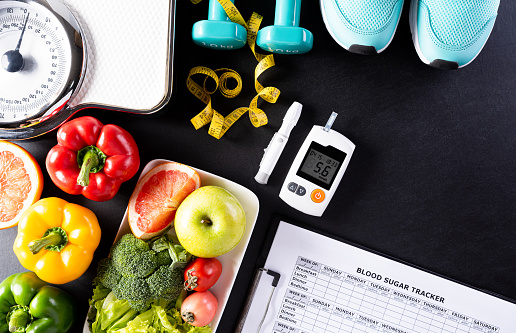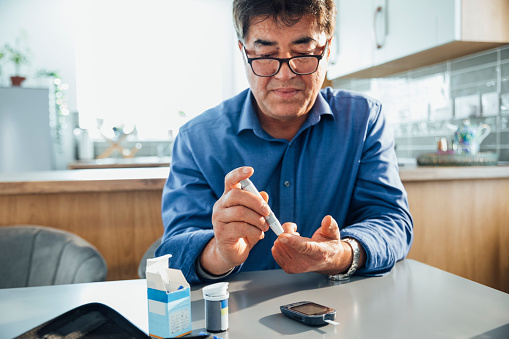"Hearst Magazines and Yahoo may earn commission or revenue on some items through the links below."
Receiving a type 2 diabetes diagnosis can be overwhelming. To begin with, there's the stress of being told that you have health condition that needs to be monitored closely. On top of that, your doctor may tell you to take new medications, try to exercise more and change your eating habits all at once. Fortunately, this guide should make the eating part a little easier.
Let's get started with what type 2 diabetes is.First, it’s helpful to have a little background information about what exactly a type 2 diabetes diagnosis means. When you eat, your body turns food into glucose, which the hormone insulin then shuttles to other parts of your body that need to use it as fuel. In a person with type 2 diabetes, the cells in your muscles, fat and liver don’t respond to insulin properly so an excess of glucose remains in your bloodstream, which can have dangerous consequences if left untreated.
Why does diet matter for type 2 diabetes?You can make some adjustments to the way you eat to help prevent blood sugar spikes. “Diabetes can be much better controlled when an individual makes food choices that are going to help them manage their blood sugar levels and keep their levels within ranges that will keep them safe,” says Colleen Johnson, M.S., R.D.N., adult diabetes educator at Joslin Diabetes Center in Boston. “Diabetes can be treated with many kinds of medications and different types of insulin, but the diet is really going to be key no matter what type of treatment they undergo.”
The main focus of an eating plan for type 2 diabetes typically revolves around reducing your intake of simple carbohydrates (like white bread, rice and potatoes — as well as sugar) because they are most easily converted into glucose. “When it comes to carbohydrates, what I like to remind people is that they are team players,” says Samantha Cassetty, R.D.N., nutrition and wellness expert and the author of Sugar Shock. “I think the biggest problem that I see is carbs on carbs on carbs. So, oatmeal with fruit with milk — those are all examples of foods that contain carbohydrates. Even our wholesome, fiber-rich carbs like fruits and vegetables really ideally operate best when they're paired with a teammate.” She says not only does it allow you to get a variety of nutrients from different types of foods, it helps balance your blood sugar and enables you stay to fuller longer.
Story continues
The American Diabetes Association recommends filling half your plate with non-starchy vegetables, a quarter of it with complex carbohydrates and the last quarter with a source of protein. That said, Cassetty points out that its best to talk to your doctor or a nutritionist to figure out the carbohydrate range that will work best for your body.
Below, you'll find some of the best foods to incorporate into your diet if you have type 2 diabetes:
Photo credit: haoliang - Getty Images
1. Leafy greensFill up on superstars like spinach, kale, Swiss chard and collard greens. “Non-starchy vegetables are great for adding lots of volume, and fiber to a plate with fewer calories,” says Johnson. “They also have fewer carbohydrates than starchy vegetables.”
2. Salmon“Salmon is rich in omega-threes,” says Cassetty. Unfortunately, we tend to consume too many omega-six fatty acids (which promote inflammation) and not enough omega-three fatty acids because they’re harder to come by in foods. If salmon is a stretch for you, Cassetty says canned tuna is also a source of omega-threes. (Just keep it to two or three weekly servings of light tuna to limit your mercury exposure.) Need inspiration? Check out these easy salmon dinner recipes.
3. QuinoaQuinoa is actually a seed, but it’s considered to be a protein-rich whole grain. In fact, one cup of cooked quinoa has 8 grams of protein and 5 grams of fiber. Plus, research shows that eating it daily can help stabilize blood glucose levels.
4. BroccoliThere’s a reason parents try so hard to get gets to eat this green veggie—broccoli is really good for you! It’s high in nutrients like vitamin C and potassium as well as fiber. “If you're not like that crazy about, let's say, steamed broccoli, maybe you should try it roasted with olive oil and some Everything but the Bagel seasoning,” suggests Cassetty. “I think we forget that food should taste good. We can play it up.”
5. NutsAlmonds, walnuts, pistachios, hazelnuts, cashews … take your pick! “Nuts are examples of healthy fats so we always want to try to include them,” says Cassetty, who has a relationship with California Walnuts. They can be incorporated into recipes (like this quinoa risotto with arugula-mint pesto) or eaten on their own. “When we're talking to people about bedtime snacks, a handful of unsalted nuts is a really good fit,” says Kathleen Wyne, M.D., Ph.D., professor in the division of endocrinology and metabolism at The Ohio State University Wexner Medical Center.
Photo credit: Westend61 - Getty Images
6. Lean meat“Lean proteins may help reduce and delay spikes in blood sugar,” says Johnson. Chicken and turkey are more obvious choices, but you can also consider lean cuts of other meat like sirloin tips or pork loin.
7. ZucchiniZucchini noodles (a.k.a. zoodles) are popular for a reason. Not only do they pair well with nearly any pasta sauce, they’re also rich in antioxidants and fiber which makes them a great lower-carbohydrate alternative to traditional noodles.
8. AvocadoReplacing a carbohydrate-rich food with the caloric equivalent of an avocado at breakfast can help improve blood glucose levels, according to one study. Unfortunately, the abundance of healthy fats in avocados means the fruit also contain more calories than you might think. “Avocados are tough,” warns Dr. Wyne, “because it is too easy to eat too much of them so they become a source of a lot of fat. People don't eat just one slice.”
9. EggsEggs fall into the lean protein category mentioned above. Just don’t go too overboard with them as some research suggests that eating an egg every day might increase your risk of diabetes.
10. CauliflowerCauliflower is well-known as a substitute for carbohydrate-heavy foods like white rice because its texture is malleable and it can pick up a variety of flavors while you’re cooking. One cup, chopped, has 2 grams of fiber, 2 grams of protein and just 5 grams of carbohydrates. See for yourself by trying one of these hearty cauliflower-focused recipes.
A diet that includes soy-based foods (like tofu, edamame or soy milk) is linked to a lower risk of type 2 diabetes, according to research. Tofu makes for a great high-protein meat substitute while edamame can be an excellent salad topper.
12. TomatoesThere’s nothing better than a nice tomato, mozzarella and basil salad, right? Fortunately, one study found that when people with type 2 diabetes eat 200 grams of raw tomatoes every day, their blood pressure improved and their levels of a protein that makes up HDL cholesterol (the “good” kind) increased so it may help lower their risk of heart disease.
13. Olive OilOlive oil is known for the high amount of monounsaturated fatty acids it contains and research shows the oil can be beneficial for controlling blood sugars. You can cook other foods in it or use it as a base for homemade low-sugar salad dressings.
14. Shirataki noodlesShirataki noodles are translucent Japanese noodles that come from a plant native to Asia. “Shirataki noodles are going to be lower in carbohydrate, so for some people that might be satisfying enough and sort of give them that pasta vibe without needing to have some actual pasta,” says Cassetty. You might also want to check out lentil or chickpea pasta if you’re looking for other pasta alternatives.
15. CeleryWhen you’re on the hunt for fibrous and versatile vegetables, celery is a clear winner. One cup, chopped, has 1.6 grams of fiber and just 3 grams of carbohydrates. It’s a natural component in chicken soup, perfect for a blue cheese slaw with a spicy burger and works well in a variety of salads.
Yes, beans contain carbohydrates, but they also contain plenty of fiber and protein without any of the unsaturated fats you’ll find in animal protein sources. In fact, one study found that when people added a cup of legumes to their daily diet, their blood sugars improved better than folks who added a cup of whole-wheat foods to their daily meal plan. Just try to remove as much salt as you can by rinsing canned beans before you eat them.
17. FarroThings like farro, barley, spelt and millet are often referred to as “ancient grains.” “It’s like a new trend to talk about ancient grains, but some of these grains are actually really kind of cool to add to the plate,” says Johnson. “A lot of times when they're diagnosed with diabetes, people want to stay away from carbohydrates in general or they tend to think carbohydrates are bad. In reality, there's a lot of complex carbohydrate sources that would actually be really good for them.” She says the extra fiber that complex carbohydrates have will help you stay full and keep your blood sugar balanced.
18. Sweet potatoesWhile sweet potatoes are quite starchy, they’re a better option than white potatoes, says Dr. Wyne. They have a slightly lower glycemic index and contain lots of beta-carotene along with other nutrients like potassium. Plus, most people eat smaller servings of sweet potatoes than they do white potatoes and tend to prepare them in healthier ways (like roasting instead of frying).
19. ApplesJohnson says she gets asked about fruit a lot when it comes to diabetes-friendly foods. The key is to choose fruits like apples that have edible skin (and then eat the skin!). “The skin on fruits contains a lot of fiber, so when something has more fiber it tends to help delay the spike in blood sugar,” she explains. Pairing it with unsweetened peanut or almond butter will also help balance your glucose levels.
20. GarlicGarlic is like a secret weapon for eating when you have type 2 diabetes. For starters, research has found that eating garlic can help improve fasting blood sugars. On top of that, it can really kick up the flavor of vegetables you may not be used to eating and make them more enjoyable.
Bottom line:While a lot of this might feel strange, try not to think of your new eating habits as a diet of restriction — think of it as a journey to fill your body with the heart-healthy foods it needs. “A lot of people who have problems with diabetes don't have the greatest relationship with food to begin with so we have to really focus on a positive approach to food and make them feel comfortable and safe with what they are eating,” says Dr. Wyne. Give yourself some grace and try to incorporate as many of the foods above into your diet as you can.
You Might Also Like: DIABETES FREEDOM





No comments: